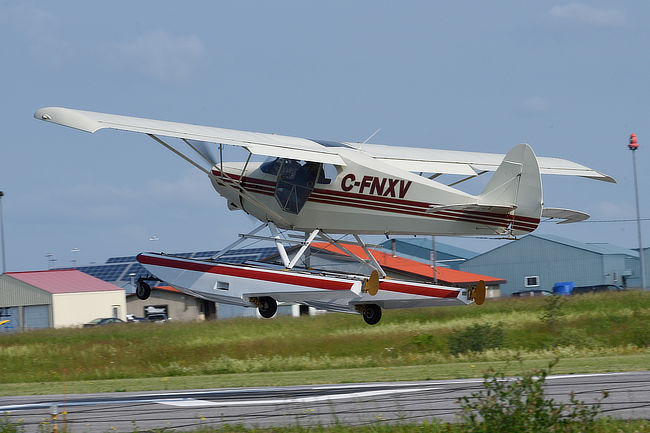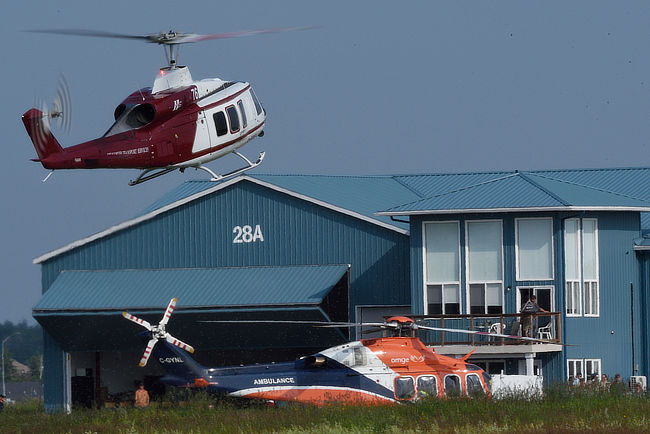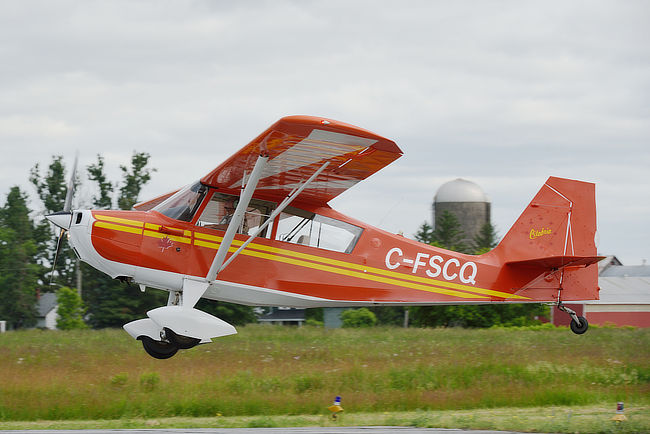ISSUE 830 - September 26, 2023 • Over 7,000 Total Ads Listed • 1,000+ NEW Ads Per Week
This eFlyer Has Been Sent To Over 150,000 Subscribers |
| Arnprior Fly-in 2023 - Part 2 |
| Kevin Moore, Contributing Writer & Photographer |
|
Last week we spent some time visiting the Arnprior/South Renfrew Municipal Airport and their first fly-in since before the Covid 19 pandemic. We now return to Arnprior to continue our look at the fly-in and the area.
|
|
| We're back to visit the Arnprior/South Renfrew Municipal Airport 2023 Fly-in with more aircraft, airport history and local information. |
|
|
| A beautiful example of a Piper PA-22-108 Colt, left, and another Van's RV-6A, right, making an appearance at the fly-in. |
|
The Piper PA-22-108 Colt closely resembles the Piper PA-20 Tri-Pacer but differs in that the Cold is a 2 seat aircraft verses the Tri-Pacer's 4 seat configuration. The Colt also lacks flaps, rear side windows, door and no second fuel tank in the wings. The Colt shares the Tri-Pacers instrument panel, windshield, front seats, landing gear, tail surfaces, struts and engine mounts. It was designed to compete with other training aircraft such as the Cessna 150. The last production PA-22-108 Colt came off the production line in 1964.
|
|
|
| The Cessna 150 has been around since the late 50s and started out as a straight tail, beefier aeroplane before its redesign to a smaller, slightly 'sleeker' version, right. |
|
The Cessna 150 has been around since it first flew in late 1957 and has been used as a training aircraft since it first appeared on the market. Though many are privately owned, there are still flying clubs around who operate the Cessna 150 as a more affordable training and/or rental option. They were built in the Cessna plant in Wichita, Kansas, commencing production in 1958. However, a separate version was built under license in France by Reims Aviation who built over 1700 of the type, known as the Reims F-150. Production changed to the 152 version in 1977 until the end of all piston single engine Cessna aircraft ended in 1985.
|
|
|
RV-8 on final, left and a Bushcaddy with fat tyres, right, passes overhead to
checkout the crosswind. |
|
Arnprior Airport is a former BCATP (British Commonwealth Air Training Plan) base that was home to No. 3 Flying Instructor School during World War II. It was also the original home of the National Research Council of Canada Flight Research Laboratory until 1954 when it was moved to Ottawa. It is currently home to OPP (Ontario Provincial Police) aircraft, Ontario Hydro aircraft, Mobility Labs (parachute development & strategic training) and Chapman Aviation who offer flight instruction, charter and sightseeing operations as well as maintenance services.
|
|
|
| The de Havilland of Canada DHC-1 Chipmunk was a versatile 2-seat, tandem training aircraft utilised around the world by air forces and by flying clubs. |
|
The de Havilland of Canada DHC-1 Chipmunk was a Canadian designed, single engine aircraft as a primary trainer, built to replace the venerable DHC.82 Tiger Moth. The Chipmunk first flew in May, 1946 at their plant in Downsview, Ontario and entered operational service the same year. It was quickly utilised by the RCAF and RAF, with the aircraft built under license in the UK by de Havilland. They were built until the mid 1950s with almost 1300 of the type built, including 66 under license in Portugal until 1961. Many Chipmunks still fly today in the hands of private owners and museums around the world.
|
|
|
| The Fleet (Fairchild) Cornell was a 2 place, tandem training aircraft used by the Royal Canadian Air Force, and the RAF, during World War II. |
|
The Fleet Cornell was built in Canada, under license, by Fleet Aircraft of Canada in Fort Erie, Ontario for the Royal Canadian Air Force, used by Elementary Flying Training Schools at BCATP bases (British Commonwealth Training Plan) during World War II, used as an elementary flying training aircraft. It differed from the American built Fairchild Cornell in that it had an enclosed cockpit, an improved heating system and was fitted with the Ranger piston engine. Fleet Canada built 2853 Cornell aircraft of which 1565 operated with the RCAF and 1288 with the RAF. The RCAF retired the last Cornell in 1948.
|
|
|
| Cavalier on final, left, and local Piper Cub on straight floats, sitting on a trailer, right. |
|
The city of Arnprior has a population of 9600. Though not a large city, Arnprior has a lot of offer including grocery stores, drug stores, several antique stores, parks, the O'Brien Theatre, a parachute school called Parachute Ottawa, Arnprior and District Museum, Cold Bear Brewing Company, Farmgate Cider, Sand Point Lighthouse, golf courses as well as both sitdown and fast food restaurants, among other things. The city of Ottawa is only a 50 minute drive or a short flight into one of the other surrounding airports such as Carp, Kars, Gatineau and Rockcliffe where you can visit the National Air & Space Museum of Canada.
|
|
|
Make plans to attend the 2024 Arnprior Airport fly-in, whether you come by taildragger, tricycle or amphibious/seaplane or you come by vehicle or foot, you'll enjoy a
delicious breakfast and good company. |
|
Future Arnprior fly-ins are expected to attract more visiting aircraft, as long as the weather cooperates of course. The folks at the airport are friendly and welcoming and they'll be more than happy to feed you, show you around and/or have a good chinwag with you. This year's event saw hundreds of visitors, not just for breakfast. Many came to check out the airport and/or the aeroplanes. Whether just out of curiosity or an interest in aviation, airports will always offer a slight mystique to many. Of course, there are those who just decided that a good breakfast that they didn't have to cook was the order of the day. Regardless, make plans to visit the fly-in in 2024. You never know what you might see.
|
|
|
| Van's RV-9A, left, and Vintage Wings of Canada's Fleet Finch, right. |
|
|
Sleek looking Glastar on straight floats, left.
The Vintage Wings of Canada's DHC-1 Chipmunk, right |
|
|
| This Rockwell Commander, left, was the largest single engine aircraft to fly in for breakfast. This Bushcaddy came in sporting a set of Tundra Tyres, right. |
|
|
| Van's aircraft, as always, were well represented at the fly-in. |
|
| Helicopter Transport Services helicopter hovering in preparation for landing with the ORNGE helicopter already parked below. |
|
| This stunning example of a Citabria just before touchdown. |
| By Kevin Moore, Contributing Writer & Photographer |
|
| |
|




























